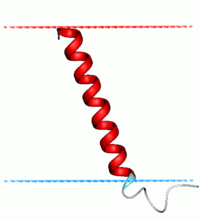Surfactant protein C
| Surfactant protein C, N terminal propeptide | |||||||||
|---|---|---|---|---|---|---|---|---|---|
 Pulmonary surfactant-associated polypeptide SP-C Protein | |||||||||
| Identifiers | |||||||||
| Symbol | SP_C-Propep | ||||||||
| Pfam | PF08999 | ||||||||
| InterPro | IPR001729 | ||||||||
| PROSITE | PDOC00298 | ||||||||
| OPM superfamily | 69 | ||||||||
| OPM protein | 1spf | ||||||||
| |||||||||
| surfactant, pulmonary-associated protein C | |
|---|---|
| Identifiers | |
| Symbol | SFTPC |
| Alt. symbols | SFTP2 |
| Entrez | 6440 |
| HUGO | 10802 |
| OMIM | 178620 |
| RefSeq | NM_003018 |
| UniProt | P11686 |
| Other data | |
| Locus | Chr. 8 p21 |
Surfactant protein C (SP-C), is one of the pulmonary surfactant proteins. In humans this is encoded by the SFTPC gene.[1][2][3]
It is a membrane protein which manufactures surfactant.
The propeptide of pulmonary surfactant C has an N-terminal alpha-helical segment whose suggested function was stabilization of the protein structure, since the latter can irreversibly transform from its native alpha-helical structure to beta-sheet aggregates and form amyloid fibrils. The correct intracellular trafficking of proSP-C has also been reported to depend on the propeptide.[4]
Clinical significance
It is associated with surfactant metabolism dysfunction type 2.
Humans and animals born lacking SP-C tend to develop progressive interstitial lung disease.
References
- ↑ Keller A, Eistetter HR, Voss T, Schafer KP (Aug 1991). "The pulmonary surfactant protein C (SP-C) precursor is a type II transmembrane protein". Biochem J. 277 (Pt 2): 493–9. PMC 1151261. PMID 1859376.
- ↑ Johansson H, Nordling K, Weaver TE, Johansson J (Jul 2006). "The Brichos domain-containing C-terminal part of pro-surfactant protein C binds to an unfolded poly-val transmembrane segment". J Biol Chem. 281 (30): 21032–9. doi:10.1074/jbc.M603001200. PMID 16709565.
- ↑ "Entrez Gene: SFTPC surfactant, pulmonary-associated protein C".
- ↑ Li J, Liepinsh E, Almlén A, Thyberg J, Curstedt T, Jörnvall H, Johansson J (March 2006). "Structure and influence on stability and activity of the N-terminal propeptide part of lung surfactant protein C". FEBS J. 273 (5): 926–35. doi:10.1111/j.1742-4658.2006.05124.x. PMID 16478467.
External links
- GeneReviews/NIH/NCBI/UW entry on Pulmonary Fibrosis, Familial
- Pulmonary+Surfactant-Associated+Protein+B at the US National Library of Medicine Medical Subject Headings (MeSH)
Further reading
- Pérez-Gil J (2002). "Lipid-protein interactions of hydrophobic proteins SP-B and SP-C in lung surfactant assembly and dynamics". Pediatric pathology & molecular medicine. 20 (6): 445–69. doi:10.1080/15227950152625783. PMID 11699574.
- Solarin KO, Wang WJ, Beers MF (2002). "Synthesis and post-translational processing of surfactant protein C". Pediatric pathology & molecular medicine. 20 (6): 471–500. doi:10.1080/15227950152625792. PMID 11699575.
- Johansson J, Curstedt T, Robertson B (2002). "Artificial surfactants based on analogues of SP-B and SP-C". Pediatric pathology & molecular medicine. 20 (6): 501–18. doi:10.1080/15227950152625800. PMID 11699576.
- Nogee LM (2004). "Alterations in SP-B and SP-C expression in neonatal lung disease". Annu. Rev. Physiol. 66: 601–23. doi:10.1146/annurev.physiol.66.032102.134711. PMID 14977415.
- Brasch F, Griese M, Tredano M, et al. (2005). "Interstitial lung disease in a baby with a de novo mutation in the SFTPC gene". Eur. Respir. J. 24 (1): 30–9. doi:10.1183/09031936.04.00000104. PMID 15293602.
- Curstedt T, Johansson J, Persson P, et al. (1990). "Hydrophobic surfactant-associated polypeptides: SP-C is a lipopeptide with two palmitoylated cysteine residues, whereas SP-B lacks covalently linked fatty acyl groups". Proc. Natl. Acad. Sci. U.S.A. 87 (8): 2985–9. doi:10.1073/pnas.87.8.2985. PMC 53818. PMID 2326260.
- Simatos GA, Forward KB, Morrow MR, Keough KM (1990). "Interaction between perdeuterated dimyristoylphosphatidylcholine and low molecular weight pulmonary surfactant protein SP-C". Biochemistry. 29 (24): 5807–14. doi:10.1021/bi00476a023. PMID 2383558.
- Glasser SW, Korfhagen TR, Perme CM, et al. (1988). "Two SP-C genes encoding human pulmonary surfactant proteolipid". J. Biol. Chem. 263 (21): 10326–31. PMID 2839484.
- Glasser SW, Korfhagen TR, Weaver TE, et al. (1988). "cDNA, deduced polypeptide structure and chromosomal assignment of human pulmonary surfactant proteolipid, SPL(pVal)". J. Biol. Chem. 263 (1): 9–12. PMID 3335510.
- Johansson J, Jörnvall H, Eklund A, et al. (1988). "Hydrophobic 3.7 kDa surfactant polypeptide: structural characterization of the human and bovine forms". FEBS Lett. 232 (1): 61–4. doi:10.1016/0014-5793(88)80386-7. PMID 3366248.
- Warr RG, Hawgood S, Buckley DI, et al. (1987). "Low molecular weight human pulmonary surfactant protein (SP5): isolation, characterization, and cDNA and amino acid sequences". Proc. Natl. Acad. Sci. U.S.A. 84 (22): 7915–9. doi:10.1073/pnas.84.22.7915. PMC 299446. PMID 3479771.
- Young WA (1966). "Familial fibrocystic pulmonary dysplasia: a new case in a known affected family". Canadian Medical Association Journal. 94 (20): 1059–61. PMC 1935417. PMID 5942662.
- Wood S, Yaremko ML, Schertzer M, et al. (1995). "Mapping of the pulmonary surfactant SP5 (SFTP2) locus to 8p21 and characterization of a microsatellite repeat marker that shows frequent loss of heterozygosity in human carcinomas". Genomics. 24 (3): 597–600. doi:10.1006/geno.1994.1673. PMID 7713515.
- Hatzis D, Deiter G, deMello DE, Floros J (1994). "Human surfactant protein-C: genetic homogeneity and expression in RDS; comparison with other species". Exp. Lung Res. 20 (1): 57–72. doi:10.3109/01902149409064373. PMID 8181452.
- Nogee LM, Dunbar AE, Wert SE, et al. (2001). "A mutation in the surfactant protein C gene associated with familial interstitial lung disease". N. Engl. J. Med. 344 (8): 573–9. doi:10.1056/NEJM200102223440805. PMID 11207353.
- Glasser SW, Burhans MS, Korfhagen TR, et al. (2001). "Altered stability of pulmonary surfactant in SP-C-deficient mice". Proc. Natl. Acad. Sci. U.S.A. 98 (11): 6366–71. doi:10.1073/pnas.101500298. PMC 33474. PMID 11344267.
This article is issued from
Wikipedia.
The text is licensed under Creative Commons - Attribution - Sharealike.
Additional terms may apply for the media files.
